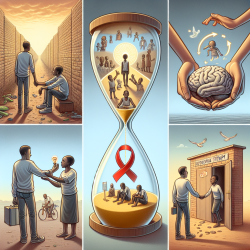Breaking Down Barriers: Supporting ART Adherence in Ugandan Youth
Adolescents and young adults living with HIV in Uganda face unique challenges in adhering to antiretroviral therapy (ART). A recent study titled “How am I going to live?” explores these barriers and provides insights that can guide practitioners in improving ART adherence among this vulnerable group.
Understanding the Barriers
The study identifies four primary barriers to ART adherence:
- Poverty: Many youths struggle to afford food, which is crucial for taking ART medications effectively. This challenge is especially pronounced in child-headed households where financial independence is a distant goal.
- School Attendance: The lack of privacy and the demands of school schedules make it difficult for students to adhere to their medication regimen. The stigma associated with taking medication in front of peers further complicates this issue.
- Family Support: The loss of biological parents to HIV often leads to inconsistent family support and frequent changes in guardianship, which disrupts the stability needed for consistent ART adherence.
- Pill Burden: The requirement to take multiple medications daily can lead to 'drug holidays,' where youths take breaks from their medication due to frustration and fatigue.
Strategies for Practitioners
To effectively support ART adherence among Ugandan youth, practitioners can consider the following strategies:
- Financial Training: Programs that teach budgeting and savings can help youths transition to financial independence, reducing the impact of poverty on ART adherence.
- School-Based Support: Schools can develop strategies to help students take their medications discreetly and consistently, minimizing the stigma and logistical challenges associated with school attendance.
- Family and Community Engagement: Engaging families, peers, and community health providers can create a supportive network that encourages adherence and addresses the challenges posed by changing guardianship.
- Addressing Pill Burden: Reducing the number of pills required or providing long-acting injectable ART can alleviate the burden of daily medication, improving adherence.
Encouraging Further Research
While the study provides valuable insights, further research is needed to explore the complex dynamics of stigma, disclosure, and peer influence on ART adherence. Practitioners are encouraged to contribute to this growing body of knowledge by conducting research in their own contexts.
To read the original research paper, please follow this link: “How am I going to live?”: exploring barriers to ART adherence among adolescents and young adults living with HIV in Uganda.










